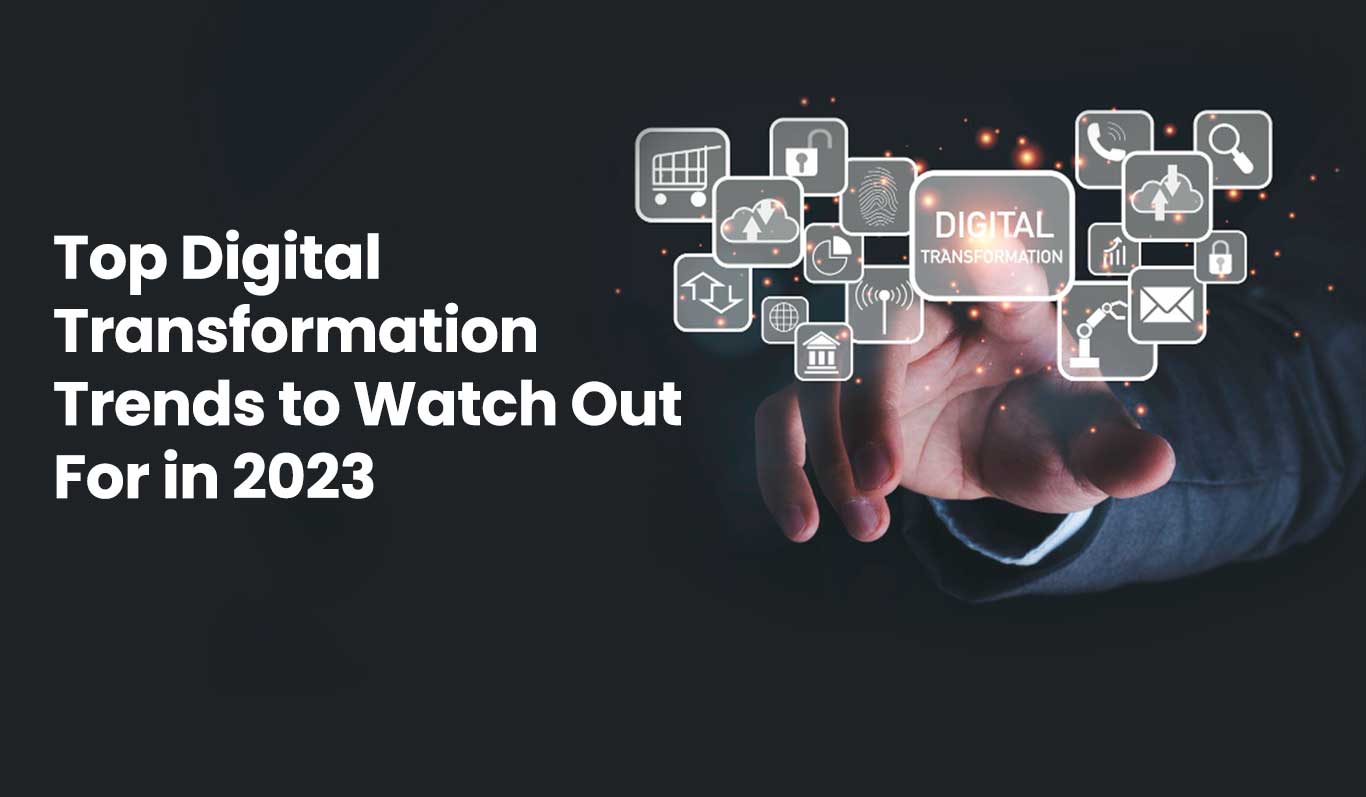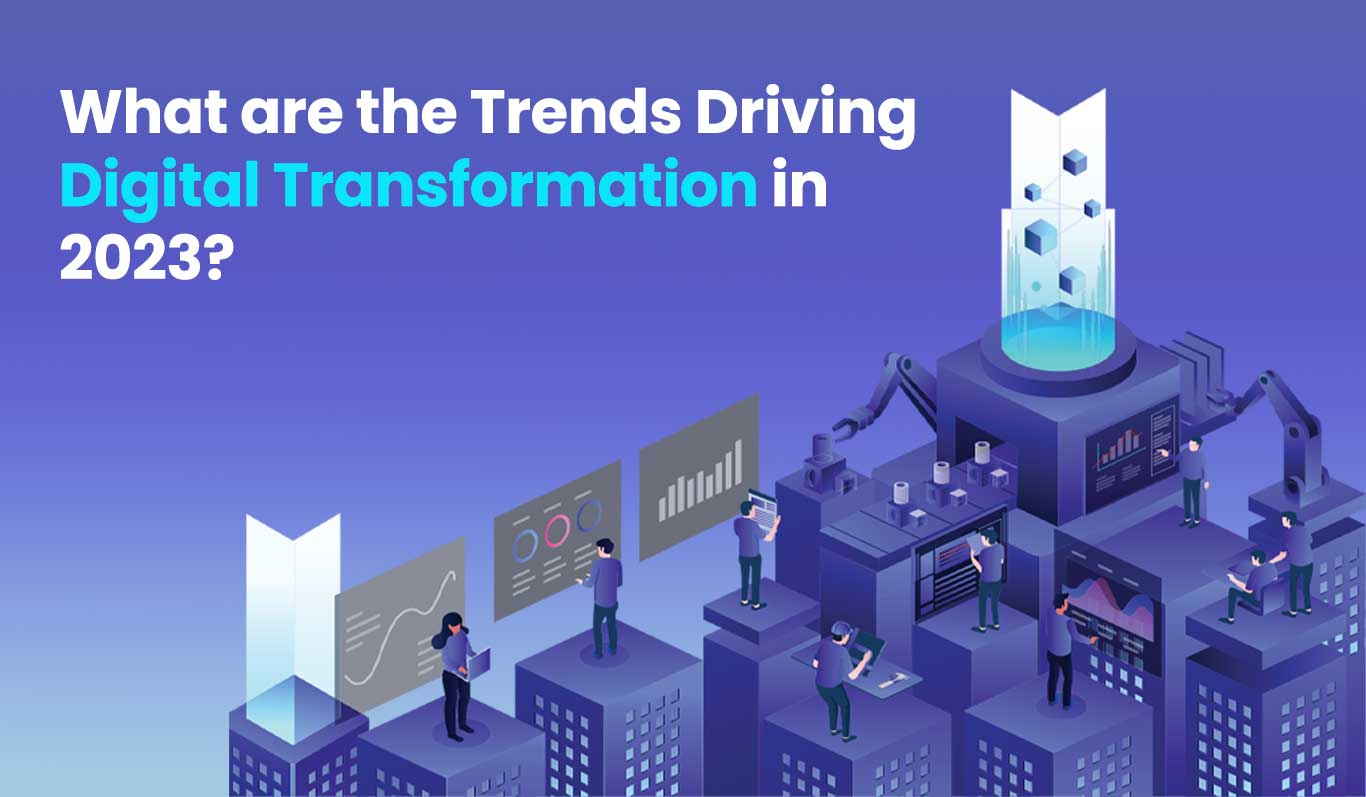Top Digital Transformation Trends to Watch Out For in 2023

It is a known fact that digital transformation and technology advancements have had an enormous impact on the world's survival over the last couple of years, particularly during the Covid phase.
Since the beginning of the Covid-19 pandemic, business technology has evolved and expanded at a rate that has seemed unimaginable in the past few years. We saw a lot of technological innovation during the pandemic and post-pandemic phase mainly due to adaptations to changing needs that arose over time. Due to this development, many companies have begun to change their approach so as to meet people's concerns rather than just relying on tried and proven methods.
Digital business trends remains on course to continue to evolve despite the world coming back to normal post Covid. Businesses can now leverage the new tools to change the way they interact with customers, make decisions, manage data, and much more.
2023 looks promising to be an year of even greater innovation and promise for IT.
What are the Trends Driving Digital Transformation in 2023?

According to our IT experts, there will be several trends on the horizon for 2023 consisting of increase in AI ML adoption, resolving supply chain crisis, Metaverse, growth focused technology, and many more.
How do you think technology will reshape our businesses and lives? Regardless of your focus, IT leaders and their teams should have an exciting year ahead.
Metaverse coming to life
As far as you know, it's still a relatively new concept, and it's not clear how it will be used or in what form it will take. We might see a few trends and developments in the metaverse in the years to come.
Among the trends that are likely to continue in the short and long term, is the increased use of virtual and augmented reality technologies in a variety of applications, including gaming, education, and entertainment to name a few. Through these technologies, users will be able to experience immersive, interactive experiences that will allow them to seamlessly interact with virtual environments and objects in an intuitive, natural, and comfortable way.
There is also a possibility that a metaverse-based platform may be used for social interaction in the near future. It is no secret that in recent years there has been a growing demand for virtual social spaces where people can come together, collaborate, and socialize in a way that has been exacerbated by the ongoing pandemic and the use of remote work. In the future, the metaverse could be used as a platform for the exchange of information and learning, allowing people to connect with one another and interact in a virtual space.
We may also witness the emergence of new business models and revenue streams driven by the metaverse over the coming years. The metaverse could be used to sell virtual goods and services, or to host virtual events.
Cost-Savings vs. Growth-Focused Transformation
Among the many digital transformation trends for 2023, costs-focused transformations are likely to be one of the leading ones. Using the cloud for instance will drive cost savings.
A very small percentage of organizations are able to manage their costs in a way that leads to sustainable success. It ends up leaving them weaker and unable to compete because they spend money on the wrong things. An organization should instead view costs as investments that will fuel their growth, as that will ensure that their money is placed where their strategy lies, and not where the costs are. It is essential for them to continually reduce bad costs and to redirect resources towards costs that build and strengthen their capacity to differentiate themselves from their competitors.
Mitigating disruptions in the supply chain
As we approach the third anniversary of the start of the COVID-19 pandemic and the wave of disruptions it caused throughout the supply chain globally, we are in the midst of a critical time. Economic uncertainty, shipping delays, supply chain bottlenecks, material shortages, and geopolitical shifts continue to affect businesses of all sizes. Planning tools and processes should incorporate flexibility, visibility, and macroeconomic risk management.
Disruptions in the supply chain, for instance, are likely to force companies to reevaluate their reliance on one single source of supply in the future. Suppliers will be required to perform joint forecasting, which will require them to share more data with OEMs-and warn them of exceptions early. To facilitate collaboration, supplier and manufacturer systems must be pre-integrated with OEM systems.
Buildings with intelligent facilities
Taking advantage of the Internet of Things, cloud computing, augmented reality, and other systems, smart building design enables day-to-day processes to be automated with IoT-connected devices, cloud computing, and augmented reality. In an intelligent building, such as a conference room, if it is known that someone normally enters a room at 11:00 in the morning, then it can adjust the air conditioning system accordingly to keep the room comfortable at the time. The HVAC system in the building can then be adjusted automatically if the individual does not arrive at 11:00 on the scheduled day.
Due to the fact that each intelligent building operates differently, there are countless possible applications that can be envisioned for the technology. For instance, smart apartments and intelligent buildings can complement each other in commercial real estate by utilizing a facility-wide network and granting tenants specific permissions. In general, most designers focus on energy efficiency or productivity.
Data Science credentials for Business Analysts
As we head into 2023, we will see more and more business analysts with data science credentials. As organizations progress towards making data accessible to all, the line between business operatives and data professionals will continue to blur as data is accessible to everyone within an organization. A new generation of data scientists will enter the business landscape and analysts will become data science certified, thus bringing them back into contact with the business landscape.
The importance of using data to aid in decision-making has grown in recent years, which has led organizations to place an increasing amount of emphasis on the use of data to inform their decision making. In an age where businesses are storing and analyzing a growing amount of data, there is a growing need for individuals who can analyze and make sense of this data to help drive decision-making and corporate strategy in a business environment. A business analyst who possesses data science skills would be well poised to do this, since they possess technical skills and the knowledge needed to analyze large datasets that can give them insights into the business.
A service-based future
It is now a reality that all products and services are being marketed as services thanks to the power of digital transformation. Security, networks, databases, communication, transportation, & even healthcare are all areas where companies are launching as a service - from 24-hour healthcare monitoring apps to Uber for transportation to AirBnB for offering your own home and hospitality services. There is no doubt that this is one of the top trends that has created disruptions in all industries and it is only going to increase further! As a result of such technological disruptions, it becomes crucial for leaders to be aware of how to develop innovative strategies that can address the expected and unexpected impacts available from these changes.
Distributed Cloud
It is likely that distributed clouds will continue to become more common as companies seek to benefit from cloud computing's flexibility and scalability while also addressing their specific needs.
Distributed clouds are cloud computing models where resources and services are delivered from multiple locations through multiple cloud service providers and/or a combination of on-premises and cloud infrastructures.
The distributed cloud could enable enterprises to benefit from cloud computing while also addressing concerns about data privacy, regulatory compliance, and network latency in the future. A distributed cloud model might be used for sensitive data inside a private cloud, while less sensitive data is stored in a public cloud.
A distributed cloud can also support edge computing applications, which are latency- and bandwidth-sensitive. The data generated by edge devices, such as sensors and IoT devices, could be processed and stored in cloud resources located nearby the devices.
AI and machine learning adoption
With the help of AI ML, businesses can automate tasks, make better decisions, and improve the experience of their customers. With the increasing availability of these technologies and the increasing ease of their use, we can expect to see companies using these technologies to gain an edge over their competitors as time goes on.
AI can be identified as one of the most prominent trends in technology to look out for in the year ahead. It has been reported by Gartner that "AI in the form of automated things and augmented intelligence has been being used to augment IoT, edge computing and digital twin technologies to further enhance productivity.
Wider use of IoT
There is still a lot of confusion about what the internet of things is, but what IoT really means is a network of physical devices, called the Internet of Things (IoT), which are connected to the internet and which can communicate with each other and with other devices. Due to the growing number of connected devices, businesses will have more opportunities in the near future to collect and analyze data from these devices in order to improve the operations and services they provide.
Focus on cybersecurity
There is an increasing number of businesses moving their operations online and relying on digital technologies to operate, and it is crucial that they ensure that their systems are secure and that their data is safe. It has become increasingly essential for businesses to take steps to protect themselves and their customers against cyber threats, such as malware, ransomware, and data breaches, in the coming years. This has led to security being one of the most important issues for them to consider in the coming years.
A lot of business and personal activities are being conducted on the internet today, and that is one of the reasons for this. With the increasing use of online services by people and organizations, cyber-attacks and data breaches are becoming more frequent and more sophisticated. A second reason for the increase in cyber threats is their increasing complexity. There are constantly new and more sophisticated methods that cybercriminals are using to attack systems and steal sensitive data, and they develop these techniques on a regular basis. To combat these threats, businesses and individuals need to take an active role in proactively protecting themselves against them and being vigilant.
There may also be an increase in the importance of cyber security due to regulatory and compliance issues. As a result of the enactment of various laws and regulations around the world, businesses have been instructed to take certain steps if they wish to protect sensitive data and make sure that their systems remain protected from cyber attacks. Due to these changes, companies may need to invest more in cyber security measures in order to ensure they meet these security requirements in the future.
Virtual and augmented reality
Using virtual reality (VR) and augmented reality (AR) technologies, users are able to experience and interact with virtual or enhanced versions of the real world that allow them to interact with it more naturally. Many industries are expected to adopt these technologies over the coming years, including entertainment, education, healthcare, and other industries, such as the automotive sector.
Developments in the autonomous system field
While a few enterprises have already adopted automation to some extent, in 2023, the level of investment in the technology is going to exceed the isolated cases that have been seen so far. The purpose of this initiative will be to assist business leaders in doing more with less resources on hand. Over time, they are certain to be able to drive efficient growth, enhance productivity, and reduce costs, despite economic uncertainty caused by surging inflation, rising energy costs, and the scarcity of labor due to geopolitical circumstances.
As predicted by Gartner, organizations will be able to reduce operational costs by 30% by implementing hyper-automation by 2024. In 2025, the market for hyper-automation software will reach a value of nearly $860 billion, according to an analysis by Gartner.
As business leaders, we will see further progress in the creation of autonomous systems, especially in the delivery and logistics sectors. In fact, there are already many factories and warehouses that are partially or completely autonomous. The year 2023 will see more and more self-driving trucks and ships, as well as delivery robots - and we will even see more warehouses and factories integrating autonomous technology into their operations.
Digital Twins
Businesses are increasingly recognizing the potential they can provide and finding ways to make use of them as they discover the possibilities they offer. A digital twin can enhance business resilience through technology if used in conjunction with other aligned technologies such as AI, machine learning, and metaverse. Using a digital twin, organizations can simulate and analyze different scenarios to optimize logistics and transportation processes and improve the flow of goods through their supply chains.
Technology that is more sustainable
Finally, by the year 2023 we will begin to see a push towards technology that is more sustainable. In today's world, most people are addicted to technology such as their smartphones, tablets, and computers - but where do the parts that turn our favorite gadgets into reality come from? There will be a greater focus on the origins and consumption of rare earth components for things like computer chips.
In addition to those cloud services, we use Spotify and Netflix, which run in huge data centers that consume a large amount of power.
In 2023, we will continue to see a surge in the demand for greater transparency in supply chains as consumers demand that the products and services that they invest in are backed by more sustainable technologies as well as being energy efficient.
Conclusion
Technology is a key component of our hyper-connected age. You'll discover new market opportunities as you examine these essential software buzzwords, enabling you to move ahead of the pack and help you stay there. You can start the new year off right by understanding these ten tech buzzwords in 2023.
FAQs
How has digital transformation changed over the last few years?
There are three main digital transformation trends that are affecting organizations today: the management of change, the growth of cloud migrations, and the use of advanced technology such as Artificial Intelligence and Machine Learning. With the aid of these trends, you can increase your competitiveness and adaptability, which will help you to future-proof the business model and help you to become more competitive.
Can you tell me which IT technology is most likely to be in demand in 2023?
Cybersecurity and cryptography skills are highly sought-after by IT employers. A continuous learning mindset is also necessary for professionals who work with blockchain technology.
What technology will be trending in five years' time?
Technological trends are constantly changing, and new innovations are being developed constantly, which makes it difficult to predict which specific technologies will trend within the next 5 years. In spite of this, there are a few areas that are likely to experience significant growth and development in the coming years, like AI, machine learning, and the Internet of Things, virtual and augmented reality, cloud computing, and blockchain technology. In the next five years, the amount of growth that will be seen in these areas is likely to be significant.
Request a Quote
Categories
Popular posts
Best Practices for Software Product Engineering Every CTO Should Implement
2023-14-18How to Build Your Own On-Demand Carpooling App Services?
2023-08-25How to Start an On-Demand Fuel Delivery Business: A Comprehensive Guide
2023-07-28Empowering Miners: How Fleet Management Apps are Transforming the Mining Industry?
2023-07-21A Complete Guide to Develop a Food Delivery App for Restaurants in 2023
2023-07-08Mobile Apps Transforming the Travel Industry: A Game-Changer in Travel Planning and Experience
2023-07-07
